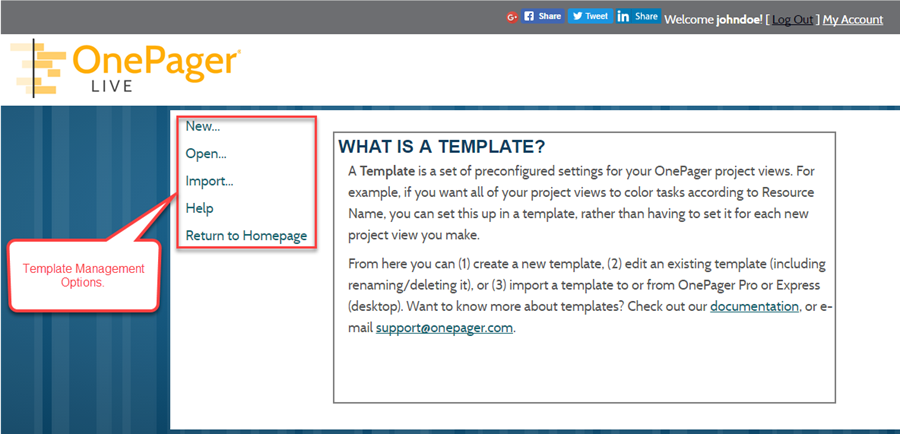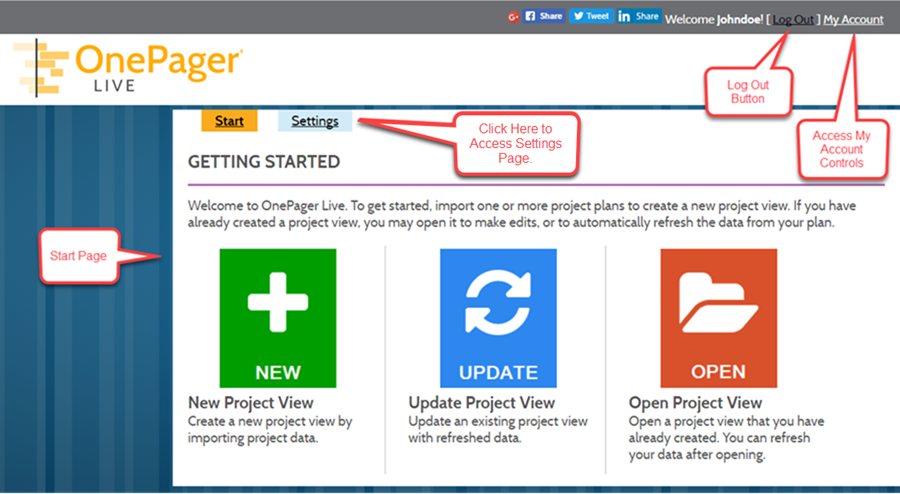Difference between revisions of "Managing Templates for OnePager Live (Portal)"
(→Creating a New... Template) |
(→Creating a New... Template) |
||
| Line 45: | Line 45: | ||
:d) After editing and creating the '''new Template''' it will appear in all list of '''Templates''' available to the '''Work Group''' and may be edited once the '''Create New Template''' button is clicked: | :d) After editing and creating the '''new Template''' it will appear in all list of '''Templates''' available to the '''Work Group''' and may be edited once the '''Create New Template''' button is clicked: | ||
| − | <center>[[File: | + | <center>[[File:LL2-24_0_1-OPL2-(5)-07122017.png]]</center> |
| + | <center>L2-24_0_1-OPL2-(5)-07122017.png</center> | ||
| − | 6) After editing the '''new | + | 6) After editing the '''new Template''' you have several options: |
| − | :(1) You may '''Save''' the | + | :(1) You may '''Save''' the '''Template''' using the '''Save''' button in the lower right corner of the form as shown above. |
| − | :(2) You may ''' | + | :(2) You may '''Save the Template as''' some other name by clicking on the '''Save As (Change Template Name)''' in the upper right corner. This action gives you the flexibility to change the name of the '''Template''' now or to change the name of the "Template''' later, if desired. |
| − | :(3) You may ''' | + | :(3) You may '''Delete''' the '''Template''' altogether from the system by clicking the '''Delete''' button. |
| − | :4) You may ''' | + | :(4) You may '''Export''' the '''Template''' as a .TAT file by clicking the button in the upper right corner of the form so that it may be used with OnePager Pro or Express. |
'''Reserve this Space for Screenshot of results from clicking Export Selected Template to .TAT file.''' | '''Reserve this Space for Screenshot of results from clicking Export Selected Template to .TAT file.''' | ||
| − | :(5) Click the '''Cancel''' button which will prevent the ''' | + | :(5) Click the '''Cancel''' button which will prevent the '''Template''' from being saved as is or with its edits and you'll be returned to '''Manage Templates''' option page as shown above. |
| + | |||
| + | :(6) You may use the '''Get Enterprise Custom Fields Account:''' controls to access your online '''Enterprise Custom Field''' data for Microsoft Project. | ||
==Open... A Template== | ==Open... A Template== | ||
Revision as of 15:43, 12 July 2017
Contents
About Managing Templates
24.0.1-OPL2 7/12/2017
1) The OnePager Template specifies the initial appearance of each new project view. It is the Template from which a new project view is created and from which all of the settings in the Project-View Properties (PVP) form are initially populated.
2) A Template is a great way to achieve standardization across projects and across people! If everyone starts with the same Template, then the resulting project views will adhere to standards that make it much easier for your audiences to digest..
3) The Template is another place where you have a number of Microsoft Project or Microsoft Excel source plan fieldss from which to import into OnePager.
See the article on Field Mappings tab at the following links: Template Only Features 24.1.1-OPL for more instructions on how to utilize all Microsoft Project and Microsoft Excel source plan fields.
Accessing the OnePager Template
1) Templates are accessed from the OnePager Live Home page also called the Getting Started page by clicking on the Settings button at the top of the page as shown below:
2) Clicking the Settings button takes you to the Settings page where you'll find the Manage Templates button as shown here:
3) When you click the Manage Templates button the page below will appear. You may now select the appropriate Template management option shown:
Creating a New... Template
4) Click the New... button brings up the Create a New Template form where you specify the name of your new Template as shown below:
5) After entering your new Template's name, click the Create New Template button.
- a) This brings up the Single Project - Permanent (Read Only) template shown below.
- b) This Template will appear with your designated Template name showing at the top of the form.
- c) At this point make any desired changes.
- d) After editing and creating the new Template it will appear in all list of Templates available to the Work Group and may be edited once the Create New Template button is clicked:
6) After editing the new Template you have several options:
- (1) You may Save the Template using the Save button in the lower right corner of the form as shown above.
- (2) You may Save the Template as some other name by clicking on the Save As (Change Template Name) in the upper right corner. This action gives you the flexibility to change the name of the Template now or to change the name of the "Template later, if desired.
- (3) You may Delete the Template altogether from the system by clicking the Delete button.
- (4) You may Export the Template as a .TAT file by clicking the button in the upper right corner of the form so that it may be used with OnePager Pro or Express.
Reserve this Space for Screenshot of results from clicking Export Selected Template to .TAT file.
- (5) Click the Cancel button which will prevent the Template from being saved as is or with its edits and you'll be returned to Manage Templates option page as shown above.
- (6) You may use the Get Enterprise Custom Fields Account: controls to access your online Enterprise Custom Field data for Microsoft Project.
Open... A Template
7) When you click the Open... button the form below will appear which gives you the option to select a desired template to open and the options to access that template:
8) Clicking the Open Selected Template button will immediately display the selected template which will then become available for editing and subsequent saving if desired.
Help Button
9) Clicking the Help button will return you to the What is a Template? form at the Manage Templates option page as shown here:

Return to Homepage
10) Clicking the Return to Homepage will return you to OnePager Live's Home page also know as the Getting Started page as shown below:

Related Links
11) The article link below should be consulted for template only features associated with Microsoft Project, Microsoft Project Server, Microsoft Project Online, and Microsoft Excel within the Template Properties form’s Main tab, Advanced tab, and Other Column’s tab.
| Template Only Features 24.1.1-OPL |
6) The remaining links below provide specific information on using OnePager Live's Enterprise Custom Fields feature, column splitting and parsing features for both Microsoft Project and Excel source files, and how to manage the current template.
| Using Enterprise Custom Fields from Microsoft Project 24.3.1-OPL |
| Splitting and Parsing Columns 24.4.1-OPL |
| Managing the Current Template 24.6.1-OPL |
(24.0.1-OPL)